
A tram-train is a type of light rail vehicle that both meets the standards of a light rail system, and also national mainline standards. Tramcars are adapted to be capable of running on streets like an urban tramway but also be permitted operation alongside mainline trains. This allows services that can utilise both existing urban light rail systems and mainline railway networks and stations. It combines the urban accessibility of a tram or light rail with a mainline train's greater speed in the suburbs.
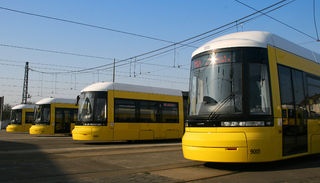
The Berlin tramway is the main tram system in Berlin, Germany. It is one of the oldest tram networks in the world having its origins in 1865 and is operated by Berliner Verkehrsbetriebe (BVG), which was founded in 1929. It is notable for being the third-largest tram system in the world, after Melbourne and St. Petersburg. Berlin's tram system is made up of 22 lines that operate across a standard gauge network, with almost 800 stops and measuring almost 190 kilometres (120 mi) in route length and 430 kilometres (270 mi) in line length. Nine of the lines, called Metrotram, operate 24 hours a day and are identified with the letter "M" before their number; the other thirteen lines are regular city tram lines and are identified by just a line number.

The Kyiv Tram is a tram network that serves the Ukrainian capital Kyiv. The system was the first electric tramway in the former Russian Empire and the fourth one in Europe after the Berlin, Budapest, and Prague tramways. The Kyiv Tram system currently consists of 139.9 km (86.9 mi) of the track, including 14 km (8.7 mi) of two Rapid Tram lines, served by 21 routes with the use of 523 tram cars. However, the system is being neglected, the serviced track length is decreasing at a fast rate and is replaced by buses and trolleybuses.
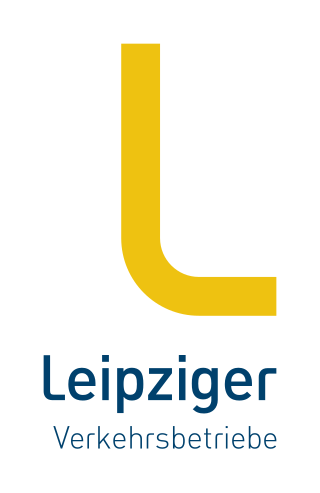
The Leipziger Verkehrsbetriebe (LVB), literally translated into English as the Leipzig Transport Authority, operates the tramway and bus transport services in Leipzig, Germany. The LVB network is a part of the regional public transport association, the Mitteldeutscher Verkehrsverbund (MDV). The LVB was formed by the merger, from 1 January 1917, of two predecessor undertakings, the Großen Leipziger Straßenbahn and the Leipziger Elektrischen Straßenbahn. The merged undertaking was also known as GLSt until it was reorganized and renamed as the LVB, from 29 July 1938.

Trams make an important contribution to public transport in the city of Zurich in Switzerland. The tram network serves most city neighbourhoods, and is the backbone of public transport within the city, albeit supplemented by the inner sections of the Zurich S-Bahn, along with urban trolleybus and bus routes, as well as two funicular railways, one rack railway and passenger boat lines on the river and on the lake. The trams and other city transport modes operate within a fare regime provided by the cantonal public transport authority Zürcher Verkehrsverbund (ZVV), which also covers regional rail and bus services.

The Frankfurt am Main tramway network is a network of tramways forming a major part of the public transport system in Frankfurt am Main, a city in the federal state of Hesse, Germany.

The former capital of the Ottoman Empire was once served, on both its Asian and European sides, by a large network of trams in Istanbul. Its first-generation tram network first operated as a horse tram system starting in 1871, and was eventually converted to electric trams in the early twentieth century. The original tram network finally closed in 1966.

Trams in Vienna are a vital part of the public transport system in Vienna, capital city of Austria. In operation since 1865, with the completion of a 2 km (1.2 mi) route to industrial estates near Simmering, it reached its maximum extent of 292 km (181.4 mi) in 1942. In February 2015, it was the fifth largest tram network in the world, at about 176.9 kilometres (109.9 mi) in total length and 1,071 stations.

The Bern tramway network is a network of tramways forming part of the public transport system in Bern, the capital city of Switzerland. In operation since 1890, it presently has five lines, one of which incorporates the Bern–Worb Dorf railway.
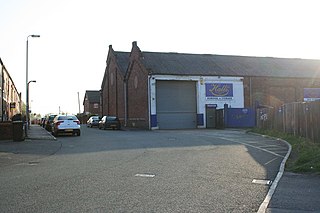
Wigan Corporation Tramways operated a tramway service in Wigan, England, between 1901 and 1931. The first tramway service in the town was run by the Wigan Tramways Company, whose horse trams began carrying passengers in 1880. They began replacing horses with steam tram locomotives from 1882, but the company failed in 1890 when a Receiver was appointed to manage it. The Wigan & District Tramways Company took over the system in 1893 and ran it until 1902. Meanwhile, Wigan Corporation were planning their own tramway system, obtaining an authorising Act of Parliament in 1893, and a second one in 1898. This enabled them to build electric tramways, and in 1902, they took over the lines of the Wigan & District Tramways Company.
At the peak of Britain’s first-generation tramways, it was possible to travel by tram all the way from Pier Head at Liverpool to the Pennines in Rochdale by tram.

The Biel/Bienne tramway network was part of the public transport network of the bilingual city of Biel/Bienne, in the canton of Bern, Switzerland, and its environs for more than 70 years. Opened in 1877, the network operated as a horsecar tramway (Rösslitram) until 1902, when it was electrified and converted from 1,435 mmstandard gauge to 1,000 mmmetre gauge.

The Erfurt Stadtbahn is a light rail network that is the basic public transit system of Erfurt, the capital of Thuringia in Germany. It represents the evolution of the city's original tramway which, outside of the city center, travels on track in its own right-of-way. The meter gauge network is made up of six lines, and has a total route length of 45.2 kilometers (28.1 mi), making it one of Germany's more moderate-sized Stadtbahn networks. The network is run by Stadtwerken Erfurter Verkehrsbetriebe AG, and is integrated in the Verkehrsverbund Mittelthüringen (VMT). The Stadtbahn carried 41.933 million passengers in 2012, which corresponds to about 114,885 passengers per day.

The Bonn tramway network forms part of the public transport system in the city Bonn, North Rhine-Westphalia, Germany, along with the Bonn Stadtbahn with which the tramlines are heavily integrated. The tram network consists of three tram lines which makes Bonn's tramway relatively small, as it comprises only 29.52 kilometres (18.34 mi) of route. The tramway is operated by 24 low-floor tramcars.

The Tbilisi tramway network operated in the Georgian capital city of Tbilisi between 1883 and 2006. In 1986 it extended to 105 km of (single) track covering 12 different routes.

The Tram System of Tallinn is the only tram system in Estonia. Together with the four-route trolleybus network (et), the four tram lines, with a total length of 19.7 km arranged in a roughly cross-shaped layout, provide a backbone for the public transport network in the Estonian capital. All the routes meet up at Hobujaama stop in the city center. Trams are unidirectional, one-sided and single-person operated, and much of the network runs on segregated two-way track.

The Nizhny Novgorod tram network comprises 16 tramlines and uses a standard Russian broad gauge. Trams have been operating in Nizhny Novgorod since 1896, but services were interrupted for a few years following the 1917 Russian Revolution.
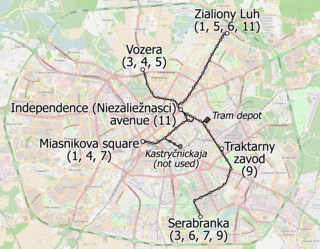
The Minsk tram network is organised into 10 routes, integrated with the city's trolleybus, Metro and bus services. It uses a Russian broad gauge, which remains the standard in the former soviet union.

The Klagenfurt tram network operated in various forms between 1891 and 1963, which was when diesel buses took over, reflecting lower operating costs at a time of relatively low prices for oil based fuels.
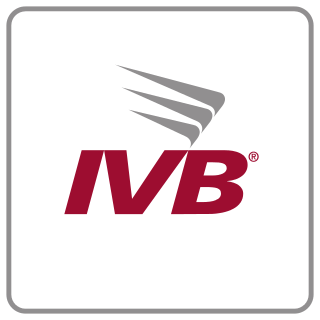
The Innsbruck tram network is currently organised over six routes and has a total length of 44 kilometres (27 mi).

Kaliningrad-Passazhirsky, also called Kaliningrad South, also referred to as Königsberger Hauptbahnhof during the German past of the city, prior to 1945, is the largest railway station on the Russian Kaliningrad Railway. It is located in the westernmost point of Russia — the city of Kaliningrad.























